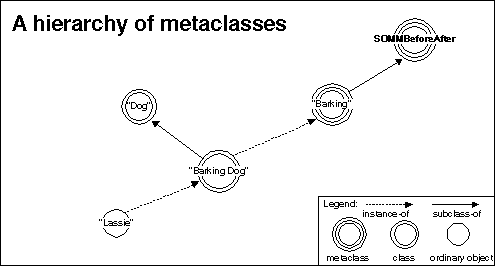Example for composition of before or after metaclasses.

When there are two before/after metaclasses -"Barking" (as before) and "Fierce",
which has a sommBeforeMethod and sommAfterMethod that both
growl (that is, both methods make a "grrrr" sound when executed). The preceding
discussion demonstrated how to create a "FierceDog " or a "BarkingDog ",
but has not yet addressed the question of how to compose these properties
of fierce and barking. Composability means having the ability to
easily create either a "FierceBarkingDog" that goes "grrr woof woof grrr
" when it responds to a method call or a "BarkingFierceDog " that goes "woof
grrr grrr woof" when it responds to a method call.
Example for composition of before or after metaclasses.

There are several ways to express such compositions. Figure 1 depicts SOM IDL fragments for three techniques in which composition can be indicated by a programmer. These are denoted as Technique 1, Technique 2, and Technique 3, each of which creates a "FierceBarkingDog" class, named "FB-1", "FB-2", and "FB-3", respectively, as follows:
┌─────────────────────────┬─────────────────────────┬─────────────────────────┐│TECHNIQUE 1 │TECHNIQUE 2 │TECHNIQUE 3 │
├─────────────────────────┼─────────────────────────┼─────────────────────────┤
│interface │interface │interface │
├─────────────────────────┼─────────────────────────┼─────────────────────────┤
│FB-1:Dog │FB-2:FierceDog, │FB-3:BarkingDog │
├─────────────────────────┼─────────────────────────┼─────────────────────────┤
│{ │BarkingDog │{ │
├─────────────────────────┼─────────────────────────┼─────────────────────────┤
│... │{ │... │
├─────────────────────────┼─────────────────────────┼─────────────────────────┤
│implementation │... │implemetation │
├─────────────────────────┼─────────────────────────┼─────────────────────────┤
│{ │Implementation │{ │
├─────────────────────────┼─────────────────────────┼─────────────────────────┤
│metaclass=FierceBarking; │{ │metaclass=Fierce; │
├─────────────────────────┼─────────────────────────┼─────────────────────────┤
│... │ ... │ ... │
├─────────────────────────┼─────────────────────────┼─────────────────────────┤
│ }; │ }; │ }; │
├─────────────────────────┼─────────────────────────┼─────────────────────────┤
│}; │}; │}; │
└─────────────────────────┴─────────────────────────┴─────────────────────────┘
Figure 1.Three techniques for composing before/after metaclasses.
Note that the explicit metaclass in the SOM IDL of "FB-1" is its derived class, "FierceBarking". The derived metaclass of "FB-2" is also "FierceBarking". Lastly, the derived metaclass of "FB-3" is not the metaclass explicitly specified in the SOM IDL; rather, it too is "FierceBarking."